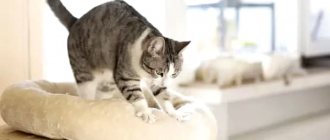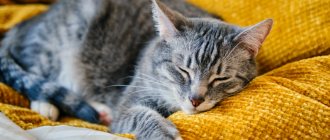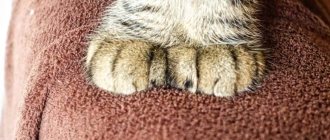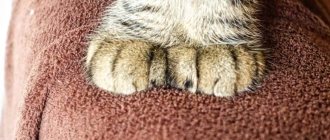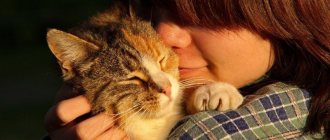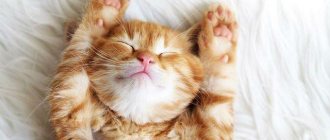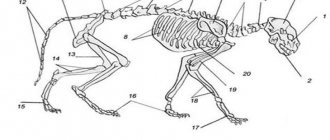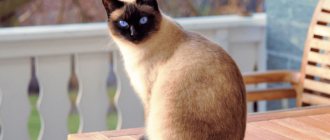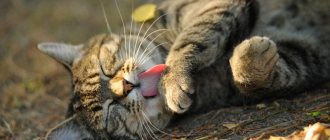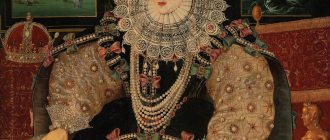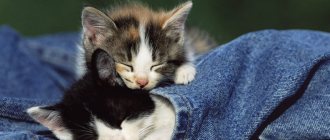Every owner sooner or later becomes interested in why a cat tramples its owner’s paws and sometimes purrs. There are many reasons for this behavior on the part of a pet, and they are all united by the feeling of affection and care that the animal shows to the person. When a cat clenches and unclenches its paws and uses them to crush things, a blanket or parts of its owner’s body, it means it feels good.
Reasons for behavior
From time to time, domestic cats stomp on a person with their paws, wrinkle the blanket and clothes of the owner, and often purr and squint their eyes. The first thing you should know about this peculiar behavior of a pet is that he feels good and comfortable. Secondly, the fluffy gives the person a signal that he loves him and cares about him, and also that the things around him are his territory. Animal psychologists identify several main reasons why a cat tramples its owner’s paws:
- infant instinct;
- massotherapy;
- belonging to “one’s territory”;
- manifestation of tender feelings.
https://youtu.be/PRgcpu92g8c
Why does a cat trample a person with its paws and purr?
Cats are amazing creatures, they sense a person’s mood and transmit their impulses to him, charging him with positive energy. Often, jumping onto the owner's lap, they perform rhythmic movements, while purring brightly. What makes them make such movements?
While sucking, kittens massage the cat's chest to enhance lactation; as a result, the adult pet continues to perform such actions, plunging into a carefree childhood
- Showing love and care for the owner is an expression of the highest degree of trust.
- Psychological release in moments of stress - loud music, unusual surroundings, unfamiliar people. It is enough to pet the animal to calm it down.
- As a way of treating the owner, the cat massages the problem area, increasing blood flow and relieving pain.
- Sense of ownership - a cat “marks” its owner, showing that he belongs only to her.
The animal shows such a state only with a person close to it; with strangers, the cat will behave restrained and wary. This is a sign of boundless trust and love!
Manifestation of children's love
On a subconscious level, the animal remembers why it did this in childhood, and, by analogy, transfers these same emotions and actions to the owner.
In infancy, the kitten kneads its mother’s tummy with its soft paws to stimulate milk production and pacify the nurse-cat, sending light rhythmic vibrations through her body. This behavior is called the milk step in a cat. When an animal grows up, the memory of childhood remains at the level of instinct and in the subconscious, so pets that have a particularly close connection with their owner consider her their mother and behave accordingly - like kittens, even if the animal is already an adult and has offspring. A prerequisite for the milk step is sleeping together with a cat: when Murka is allowed to lie and doze in her master’s bed, she instinctively crawls under the person’s side, where the body is soft and warm, and begins to trample, as in childhood.
Scientists have proven the medical effect of cat purring and paw massage: in the process of cat therapy, a person’s blood pressure is normalized, digestion is improved and metabolism is activated, fatigue is relieved, and headaches and heart pain go away.
People's opinion
There is an opinion that cats are able to stabilize the energy balance in the human body. If a cat starts doing its “massage”, it automatically exchanges biological energy, removing bad energy and giving the person its own positive energy. It has been noticed that cats most often lay down on problem areas of the body. However, this effect is not inherent in all pets, but only in those that have a powerful emotional connection with the owner.
Cats have long been credited with various mystical powers, including healing humans. At the same time, the effectiveness of feline therapy is confirmed by the results of numerous studies on this topic. There is even official information that confirms that cats can sense a pre-infarction state and find areas of localization of malignant formations.
As for therapy with cats, the famous cardiologist A.I. Lavrushin states that the animal, by trampling on the body of its owner, tries to normalize blood circulation.
Eastern sages are sure that fingering a cat’s paws is precisely a massage procedure: thus, animals relieve a person’s feeling of fatigue and tension. If claws are also used, such treatment is comparable in effectiveness to full-fledged acupuncture.
0Almost all experienced cat lovers, to one degree or another, agree with the statement that these animals are “medicinal”. After a cat stomps its paws on its sore back, it not only begins to hurt much less, but also recovers much faster. Of course, this version is quite controversial, but official science quite agrees with its “colleagues”.
It is unknown why and how a cat determines where its owner is in pain, but it really begins to do its “massage” in this very place. As a result, local skin irritation is caused, and blood flows intensively to this area. In a word, the mechanism of this action is almost similar to that during professional massage.
Massotherapy
This kind of massage of the owner’s abdomen helps to improve the health of his internal organs.
When a cat stomps on its stomach, touches its owner’s face with its paws, and purrs, it is thus performing a massage, taking care of its human. It has long been noticed that a cat massages an area of the body where there is some kind of biological problem. It is not for nothing that folk wisdom says that cats were previously kept as a family doctor, who diagnosed the presence of a problem in the organ and treated it with his rumbling, which has a healing effect on the body. Therefore, when cats move their paws in one place and purr, it is worth undergoing an ultrasound diagnosis. At pet forums, many owners noted that thanks to their pets they learned about kidney stones, heart and liver problems. How animals can recognize an illness is a mystery, but if a cat massages with its paws and purrs, clings to its owner on the bed, you should not drive it away, but watch it and listen to your own body.
I trample my feet at the call of my ancestors
Once upon a time, freedom-loving animals avoided the company of people; they had to hunt on their own, raise offspring and, of course, arrange a sleeping place for the night. Small animals love comfort, and therefore, to build a bed, they raked dry grass and leaves with their paws, crushed plants and scared away insects.
You can turn a section of forest or steppe into a cozy nest suitable for sleeping if you trample it thoroughly. Thus, the representative of the feline rhythmically compacts the cozy bed.
Other reasons
In addition to the childish instinct from the memory of kittens and a therapeutic massage session, the cat may have several other reasons for trampling. The pet most often kneads and tramples a blanket or blanket made of natural wool with its paws, which has a characteristic smell; animals also massage natural woolen sweaters. Animal psychologists are inclined to believe that the kitten (and kneading fur is most typical for babies) simply likes the smell of the products, maybe it reminds him of the warmth and aroma of his mother’s fur.
Preparation for sleep
An animal can treat something like this on which it plans to lie down to sleep.
If a cat stomps with its front paws on clothes, a blanket or a bed, this means that the pet has chosen a place to sleep and is preparing a bed for itself. At a time when cats slept in the open air, they paved a bed for themselves from fallen leaves, hay, and trampled down grass to make the bedding soft and comfortable, protecting them from the cold. In order to make themselves more comfortable, pets behave like their ancestors: they knead soft things and bedding. You can often see a cat trampling on the owner’s blanket and pillow. If you don't drive it away, it will settle down for the night next to a person's head or legs. This makes the animal feel safe.
To attract attention
Another reason why a cat crumples a soft blanket or clothes with its paws is an attempt to attract attention and flirtation. It is not difficult to recognize this meaning in behavior: if a pet jumps off when the owner approaches, runs to another place and there they repeat the “trampling ritual” - it means he is inviting you to play with him or wants to convey something to the person’s attention.
Therapeutic effect
When cats touch and crush a person with their paws, they share their energy and take away all the negativity. In addition, cat massage has other medicinal properties, due to which animals are used in medicine. Here are just a few facts:
- Cats help in the treatment of cerebral palsy, people with disabilities and autism;
- The strong energy field of animals can relieve people from the symptoms of chronic diseases;
- Felinotherapy is useful in the treatment of inflammation, gynecological problems and recovery after surgery;
- With constant contact with cats, people become less susceptible to infectious diseases;
- A cat's purring promotes bone tissue restoration and helps heal fractures;
- The sounds that a cat makes improve breathing, help fight stress and restore the nervous system.
It is worth noting the phenomenal intuition of furry pets, who subtly sense the approach of death and human illness. That is why they often come and lie on a sore spot on the body or near the bed of the dying person.
All these unique skills of pets must be appreciated by showing your attention and care for cats. Only then will they reciprocate and relieve you of headaches and stress.
How to behave with a cat that is trampling?
When trampling seals are petted, they usually hump and put their heads under the arm, asking for additional petting. gifted with attention and tenderness, the pet will return the affection a hundredfold. It happens that a cat involuntarily releases its claws while massaging the owner or her things. Sometimes, in an impulse, the cat even slightly bites your hands when you begin to caress him while trampling. These are not manifestations of aggression, but evidence of the pet’s temperament: he does not seek to hurt a person, but is simply too emotional in his impulse of pleasure. It is impossible to punish an animal in such cases. If you can’t stand the claws, you need to take the cat and take it somewhere else to hang out or build him a soft bed from a woolen blanket.
What should an owner who is in pain from the “milk step” do?
If a cat tramples you with its paws and at the same time actively releases its claws and scratches your skin, do not rush to drive it away or scold it. Such an attitude can destroy the established trust. Instead of punishment, it is recommended to try more harmless options.
Laying soft cloth
The easiest way is to carefully place a soft blanket or thick clothes under your pet that you don’t mind. Thanks to this cape, the massage will bring extremely pleasant sensations.
If the long and sharp claws continue to scratch even after placing fabric, try distracting the cat with a toy or gently turning it over on its side. Once in a lying position, she will calm down and go to sleep. It is also recommended to simply stroke the paws on top. This action will cause the claws to retract instinctively.
Cat manicure
Timely cat manicure not only prevents scratching and damage to furniture, but also prevents delamination of the claw covers. During the procedure, only the light part is cut off with a nail clipper, and the shortened claw must be trimmed with a file.
If you are afraid of harming your pet, seek help from a groomer or purchase silicone anti-scratch caps. They are fixed to the claws with special glue, which is included with the main kit.
Animal marks territory
When cats trample on the couch, they may be trying to secure sole ownership of the bed. Why did the cat need furniture? On the pads of their paws there are sweat glands that secrete special odorous substances, with the help of which these animals mark the territory so that rivals do not lay claim to it. Probably, appreciating the comfort and softness of the bed for rest and wanting to sleep on it all the time, animals try to make their desire obvious to others by moving their paws.
[custom_ads_shortcode1]
Are there cats that don't have this habit?
Artificially raised kittens that have never fed their mother's milk are deprived of this habit. For this reason, they did not develop a conditioned reflex. Sometimes, when a mother cat has a large amount of milk and few kittens, her babies also do not have the need to trample a person, because they receive food in abundance. They had no need to obtain additional food.
There are many versions of this question, but the only ones who can reliably answer it are our tailed pets. But they don’t allow people into their secret world yet.
Results
Cats are very sweet pets, whose presence in the house can bring real joy to their owner. You need to understand that sharpening its claws is a natural behavior of any cat, so you should not scold it for such actions. If you don’t like this cat’s “activity,” simply switch the cat’s attention to another object or toy. Treat your pet kindly, and he will definitely reciprocate you with love.
More from my site
- Chocolate Burmese Cat A Burmese cat with an unusual appearance and short, shiny fur, reminiscent of a smooth chocolate bar. Surprisingly, with a stern look in their eyes, these cats are flexible and [...]
- Demodectic mange is a subcutaneous mite in cats. Demodectic mange can cause severe discomfort and pain in cats. The treatment regimen depends on the stage of the disease, the age barrier and the weak immunity of the animal. Therefore, a caring owner should [...]
- Devon Rex cats Devon Rex is a cat that bestows “canine” devotion and a whole bouquet of pleasant emotions. At first glance, the Devon Rex is surprising: its strange appearance and increased friendliness; big ears and [...]
- Cat diseases Cat diseases, symptoms are what owners of furry creatures often encounter. The presented table and treatment, which you will find in the article, will help you identify cat diseases […]
- Calcivirosis in cats, treatment and consequences Calcivirosis in cats is an acute infectious disease that is widespread among all cat breeds, especially affecting unvaccinated ones. The disease cannot pass to a person, but [...]
- Cystitis in a cat treatment Treatment of cystitis in cats is an event that owners of these cute fluffies often face. After all, the problem is not so rare, and if you decide to get a pet, you need […]
- A cat yells at night - what to do How to stop a cat from yelling at night, since these sounds will certainly not allow you to live in peace. The well-being of its owner depends on the balance of the tail. This behavior can happen […]
- The Balinese cat is a graceful breed of cat. The Balinese cat was born at the beginning of the 20th century. The breed is a semi-long-haired cat with a non-standard color. Balinese or Balinese is very accessible in content, without […]
- Choosing food for your pet Many dog and cat people are accustomed to buying food for their pets in supermarkets or regular grocery stores located near their home. There you can find the most [...]
